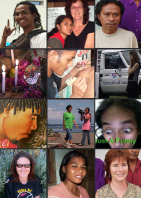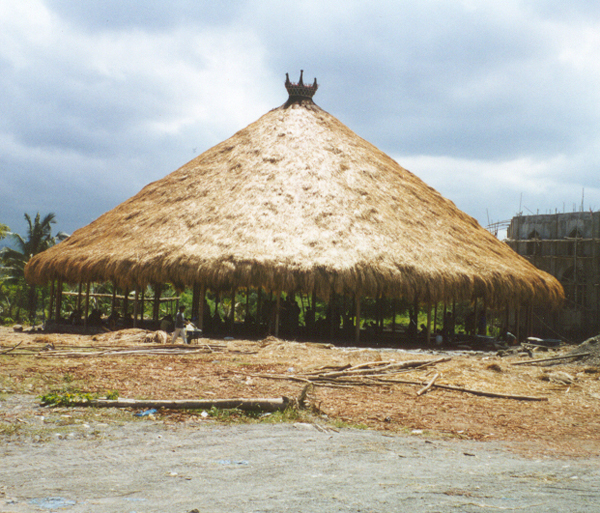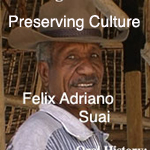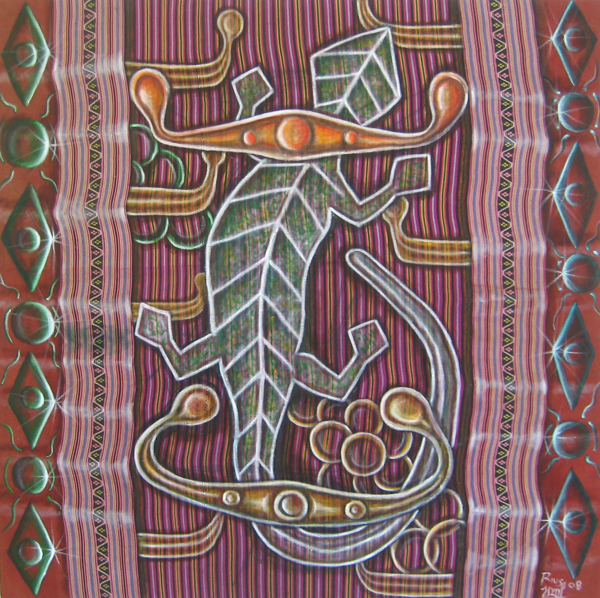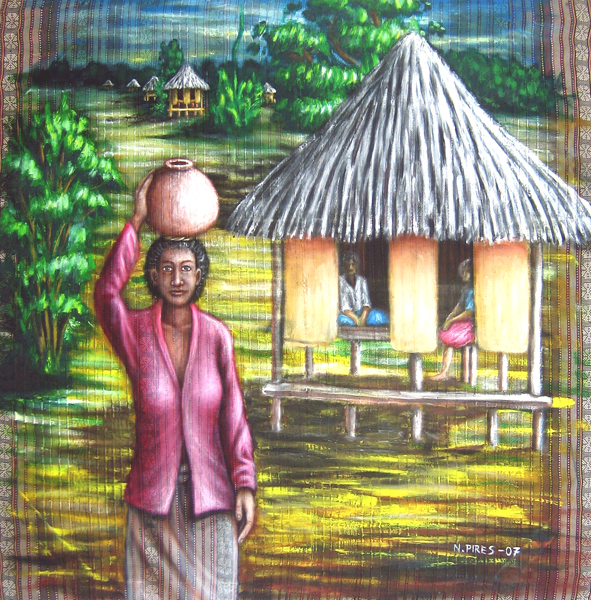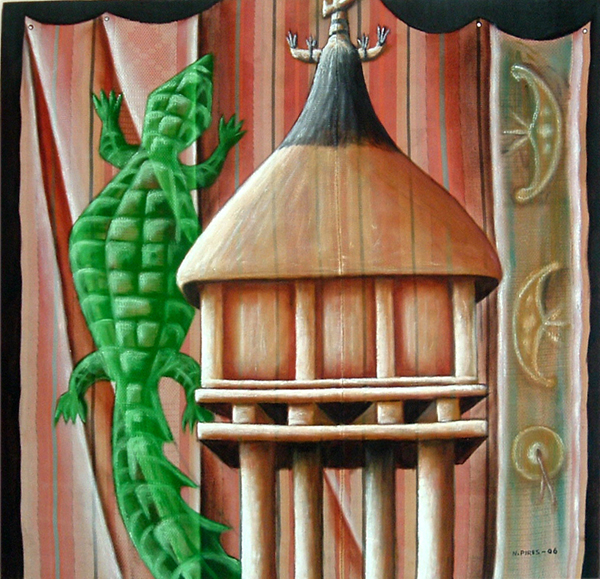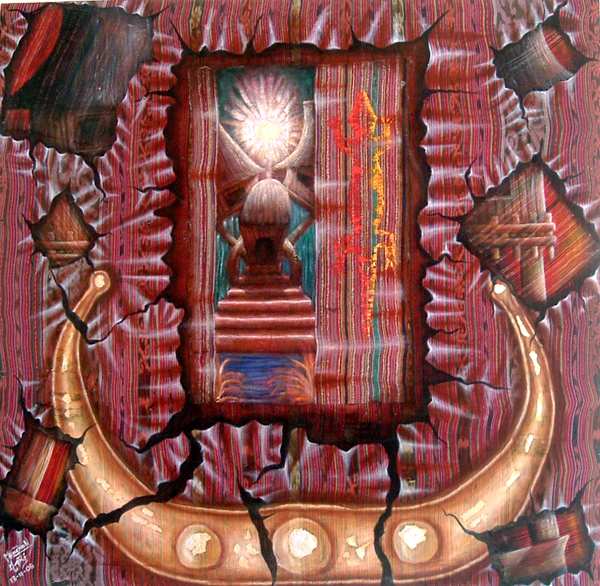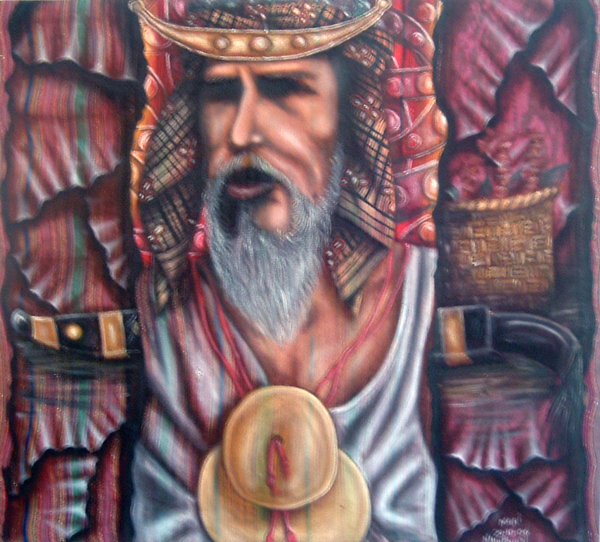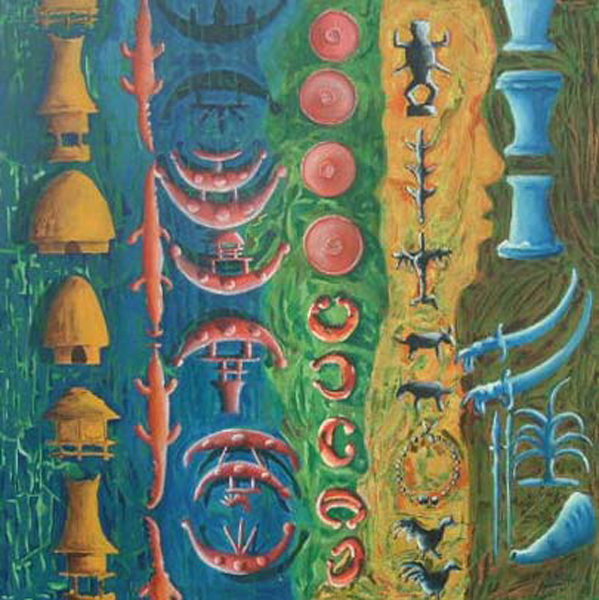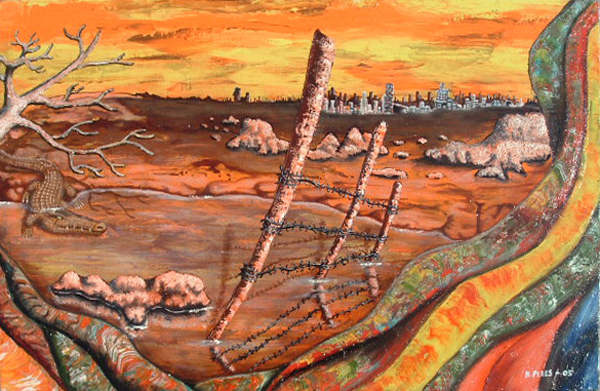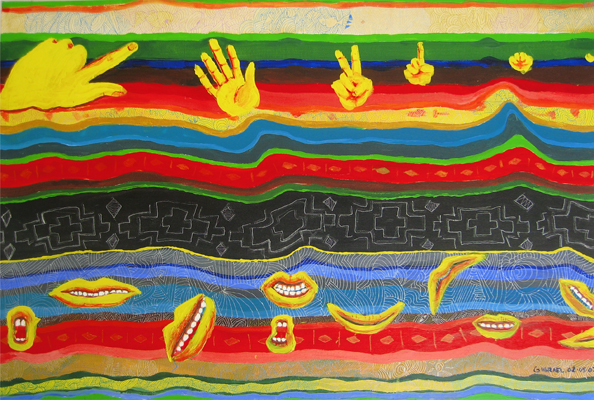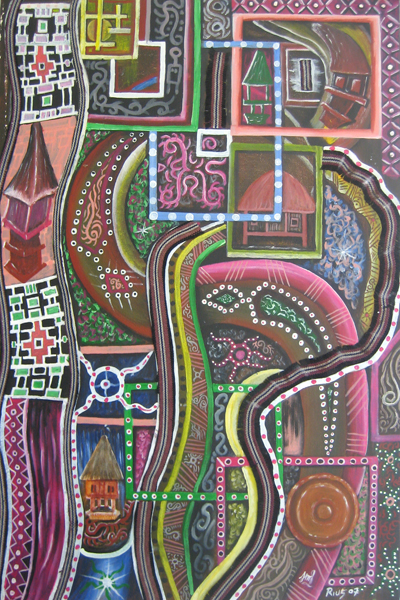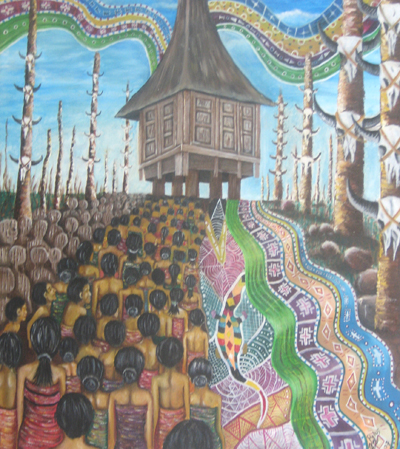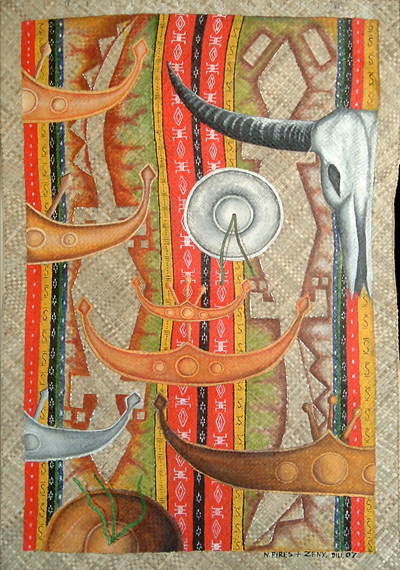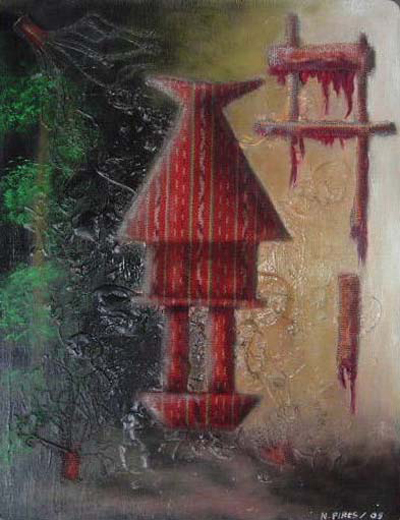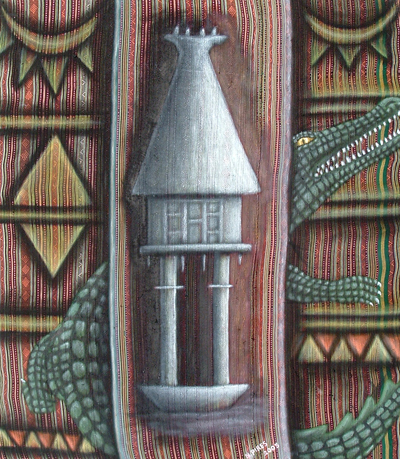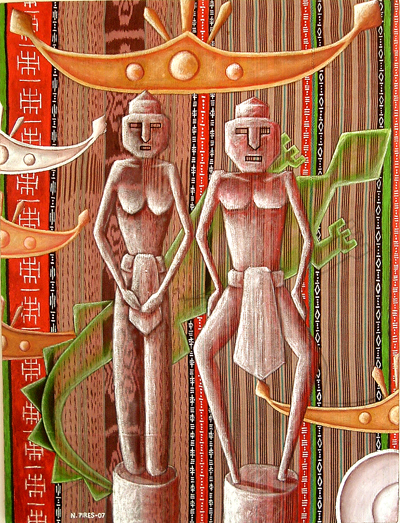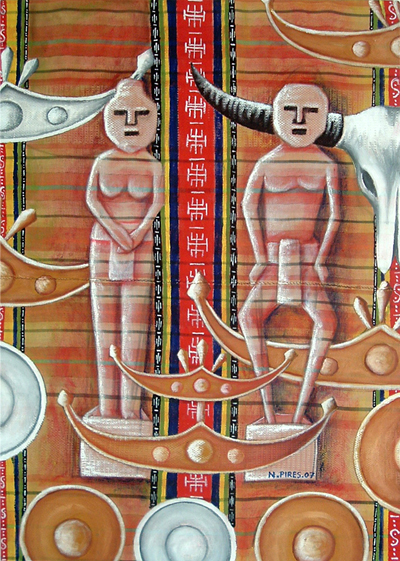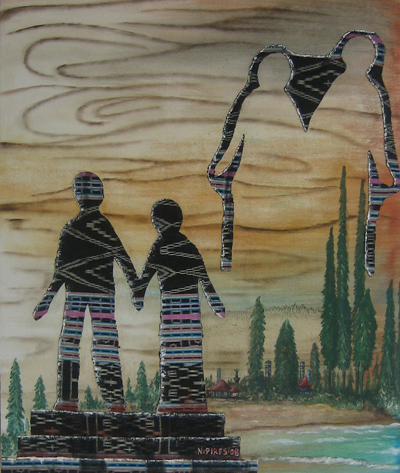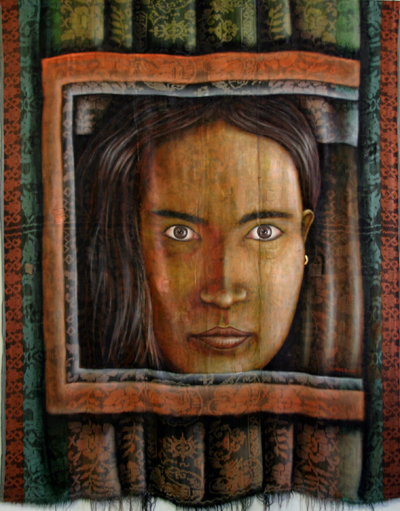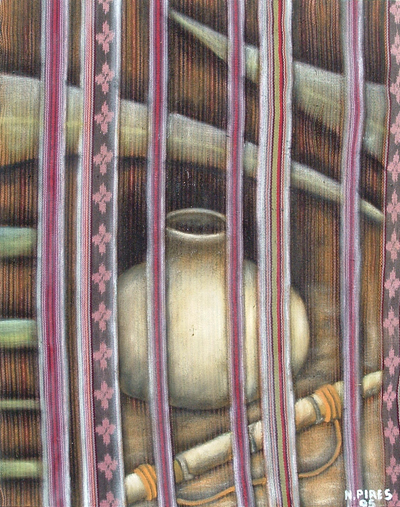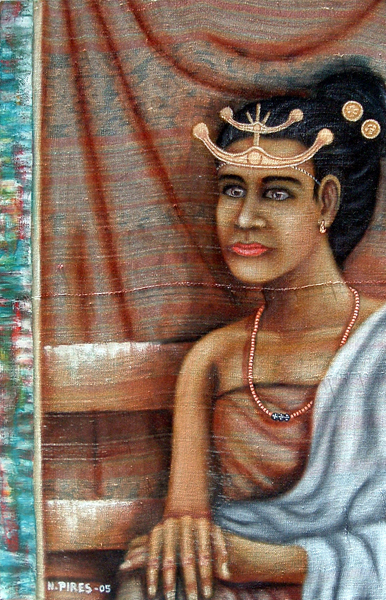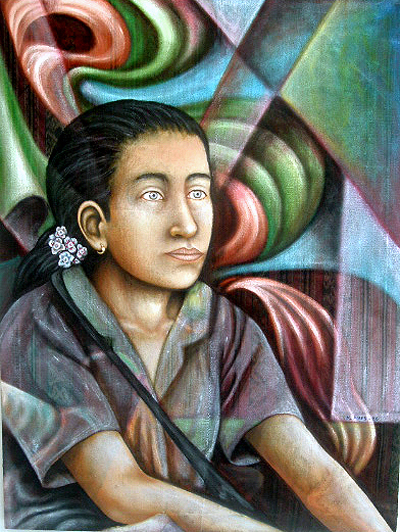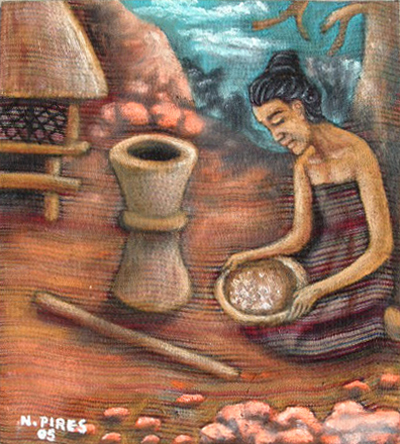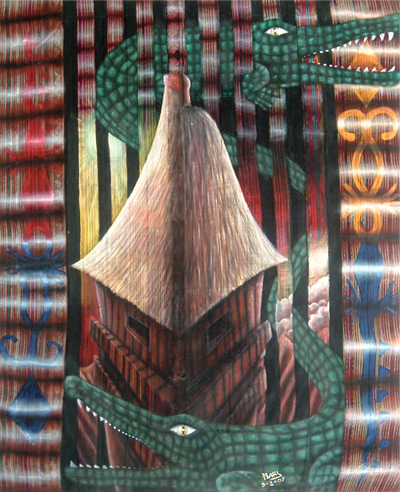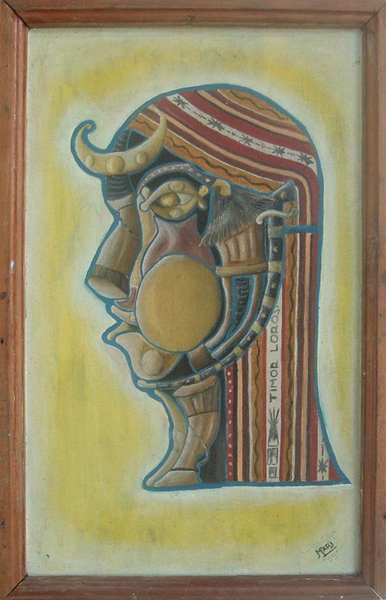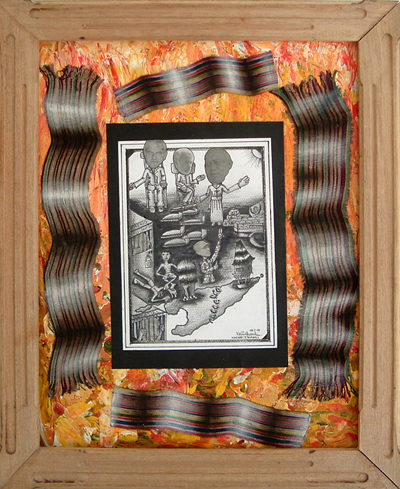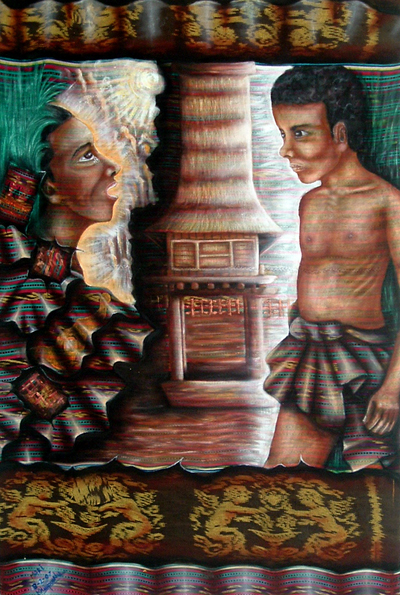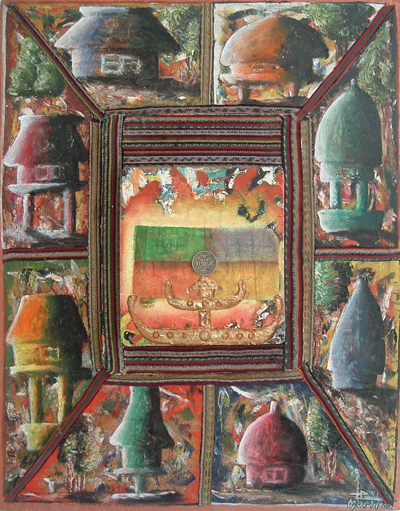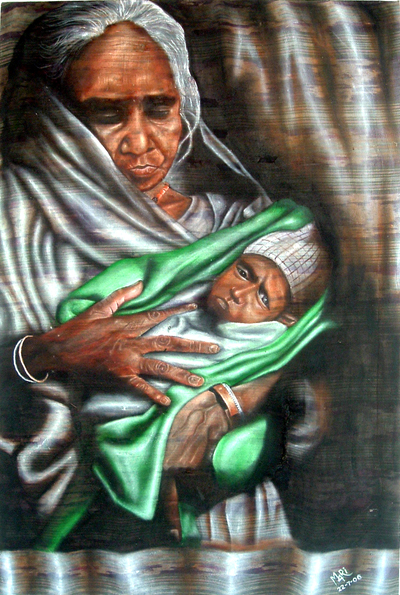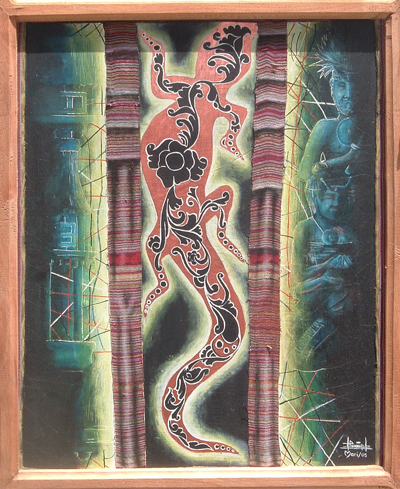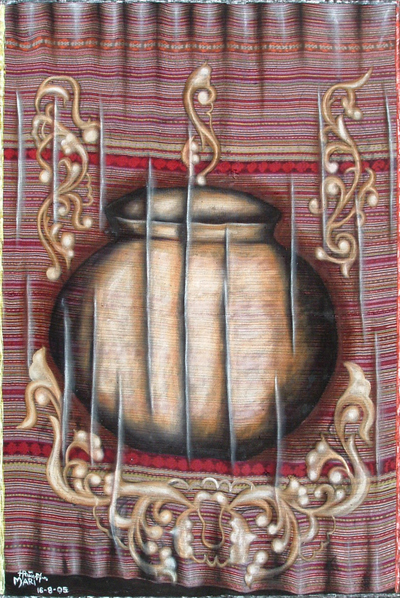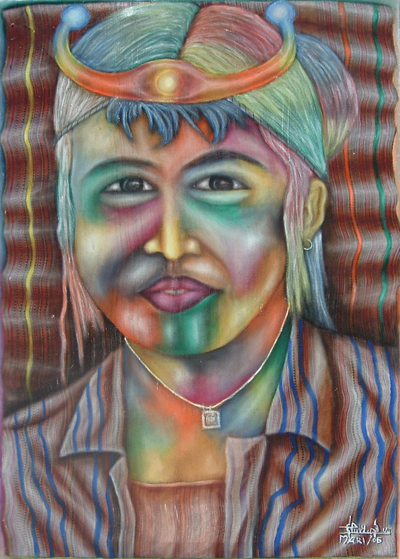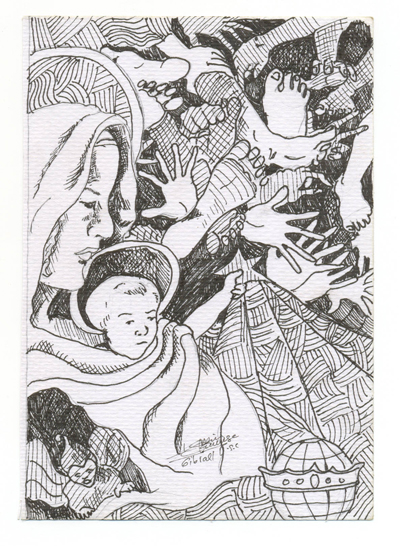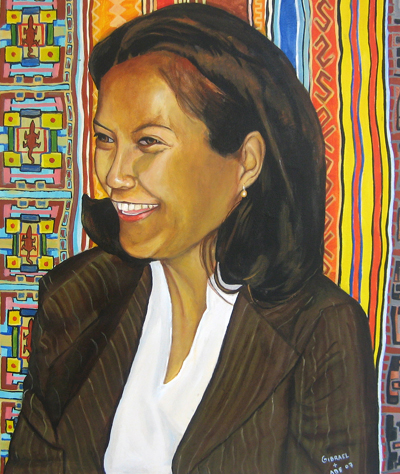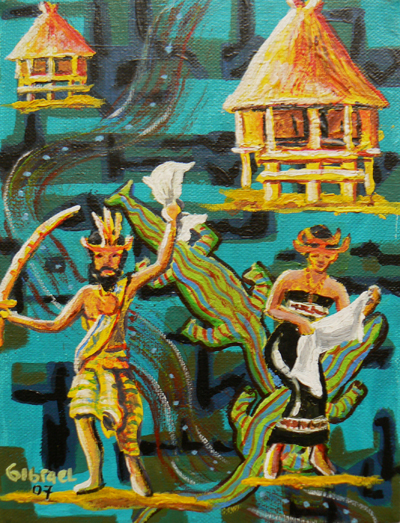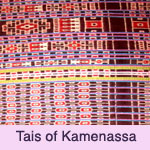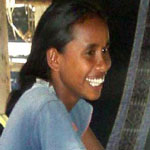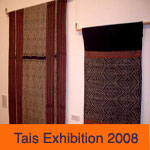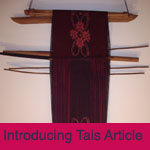English Exhibition Retratu
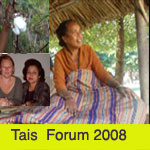
SEPTEMBER 2008, ST KILDA TOWN HALL, MELBOURNE.
La iha ema wain hanesan hau maka hetan privilegio atu hare exposisaun (pameran) tais kapas tebes ema feto Timor sira soru. Ba loron Sexta-Feira i Sabado, 5-6 Septembro 2008 hau kontente tebes tan bele hare tais kapas tebes nian mai hosi fatin barak iha rai Timor maka sai iha exposisaun iha St Kilda Town Hall (Prefeitura St Kilda), Melbourne, Australia. Iha kwartu bot kapas ida nia laran ema hatudu tais barak hosi rai Timor. Kwartu nee nian kadidin halo hosi ai maka maar tebes. Ema tara tais sira ba kadidin ai iha kwartu nee laran. Kadidin maar nee la halo tama kreta no bonde nia lian mai hosi Estrada bot St Kilda Road, i mos la halo tama lian hosi manu aman sira kokorek, lian hosi haok i nesun ba oras loro raik feto sira fai akar iha Suai.
Doutora Sara Niner (Post Graduate Research Fellow hosi Universidade Monash maka hakerek Xanana Gusmao nian biografia) organisar Exposiaun ho Forum nee kona ba tais Timor i tradisaun soru tais. Doutora Niner lori colesaun tais hosi Alola Foundation ba St Kilda Town Hall nian Galleria. La iha ema barak maka hetan sorti lao ba Timor bodik hare hodi matan i rona hodi tilun duuk nuunabe feto Timor sira tradionalmente soru tais. Ema nain atus ida karik maka hakara aprende tuaan tan teni kona ba tais i hakara fo apoio ba ema feto Timor sira soru tais presenta i tuir ceremonorio lacemento i forum nee: “Significado Soru Tais & Feto Soru Tais Sira hosi Timor Leste.”
Hau incluir tiha ona fotografia kona ba nuunabe feto sira halo futus i sui futus. Timor oan barak maka konese i hatene tais sira nee mai hosi distritu nabe. Futus i ahan hosi tais sira nee halo Timor oan sira bele hatene i konese hosi distritu nabe tais sira nee mai no mos sira hatene tais sira nee nia funsaun kona ba moris seremonial nian. Maibe, ema Malae sira sei la duun hatene dauk significado nosi tais nia futus. [Hau incluir informasaun koma ba tais sira nee iha sura fotografia tais nia ohak. Por favor, clicar ba fotografia siar nee si ita hakara fotografia siar nee sai bot. Por favour dada tun cursor centrimetro hira hosi leten too raik bodik atu ita bele hare bataun “proxima” i “anterior” ….]
Ita hare tiha ona beleza hosi tais sira nee i admirar feto Timor sira nian matenek tradicional kona ba soru tais nian. Agora ita hamutuk atu hare colesaun tais Timor hosi loro sae too loro monu, hosi tasi feto too tasi mane, maka feto matenek Timor oan sira soru, i significado sagrado, religioso, social i cultural hosi tais sira nee. Significado sira nee atu sai aat ou lakon si ita trata tais hanesan objeto mercadorio i commericio deit.
Desde 1999 ema Australiana sira barak maka ajuda feto Timor oan sira importar tiha ona tais wain bodik faan hanesan objetu commercial iha Australia neebe atu ajuda teni feto Timor oan sira soru tais ho halo sacu, bolsa, carteira, kusin falun ho cesta maka bele faan iha Australia i rai seluk sira. Agora organisadoras i participantes sira iha Forum tais nian nee atu buka hatene impactu ba feto matenek soru tais nian. Sira mos atu buka hatene impactu hosi colonialismu i aktividade pos-independencia bodik atu halo diak ou melhorar feto Timor oan sira nia moris.
Belun Suai (Friends of Suai) servisu hamutu ho ONG barak iha Australia ho Universidade Monash bodik organisar Forum kona ba tais Timor maka accontese ba loron 6 fulan Septembru 2008, ba anniversario dalam siwi hosi massacre iha Igreja Suai 6 Septembro 1999. Bodik hanoin, hadomi i hakneter (respeitu) matebian sira i familia hosi matebian sira maka terus susar, Balthasar, membru ida hosi Commissaun Friends of Sui desde 2000, hananu lia nain (poema) ida iha lia Tetum ho Ingles maka nia hakerek iha Dili iha Fulan Septembru 2006 kuando nia visita refugiaun sira maka susar iha campu refugiaun. Iha poema nee Balthasar hanoin i hafolin Timor oan sira nia unidade, solidaridade ho optimism durante funu laran. Poema nee mos kona ba tan sa ida Timor oan sira la hamutu ona, tan sa ida sira fahe malu i halo funu malu, loro sae contra loro monu, tan sa ida ulun sir oras independecia ona, tan sa ida la servisu hamutu ona, tan sa ida ulun sira la besik ona ba ema kiik sira durante independencia laran. Poema nee mos husu ba Timor oan sira, especialemente ba nai ulun sira, atu servisu hamutu hodi halo rai Timor ba oin, ba diak. Timor atu sais a ida si Timor oan sira la hamutu, si nai ulun sira foti aan i fahe malu, si nai ulun sira haluha ona matebian sira i povo kiik sira nia susar, si nai ulun sira taka tilun no matan povo kiik sira. Timor atu sai sa ida se Timor oan sira la hamutu, se nai ulun sira la hamutu, si nai ulun sira la hamutu ho povo kiik sira ona?
Ema hare iha exposasun (pameran) nee tais rua maka kapas tebe-tebes mai hosi Suai-Kamanasa, Covalima. Coordinador hosi Friends of Suai, Pat Jessen, i membru commisaun Friends of Suai ida naran Desleigh Kent hola tais rua nee iha Kamanasa ho tai seluk sira iha Suai kuando sira visita Suai iha fulan Junho 2008. Sira hola tais nee bodik Friends of Suai nian pameran iha programa pameran i forum tais Timor. Friends of Suai kleur ona halo promosaun no faan cafe Timor, maibe foin isin dala uluk ba tinan nee sira halo promosaun i faan tais Timor iha progama pameran tais Timor. Sei daun la hatene si Friends of Suai atu continua tinan ba tinan halo promosaun i faan tais Timor iha sura opportunidade maka mosu bodik atu ajuda feto sira iha Covalima tan sira halo actividade barak kona ba halo belun ho ema rai Covalima particularmente ema cidade Suai. Contudu, insiativa primeiru hosi promosaun no faan tais Covalima iha Pameran tinan nee atu loke oda matan bodik povu sira iha Cidade Port Phillip maka hakara atu apoiu feto sira iha Covalima kona ba sira nian actividade cultura soru tais.
Exposisaun ou Pameran ho Forum kona ba Tais Timor nee halo hau hatene tebes i hakara hatene liu tan teni katak tais nee forma artistic ida hosi Sudeste Asiastico (Asia Tenggara), particularmente hosi rai Timor tomak—Timor Loro Sae (Timor Timur) i Timor Loro Toba/Monu (Timor Barat). Hau aprende hosi hau nian observasaun no experiencia katak cultura tradicional ema Timor kona ba soru tais moris hamutu ho cultura tradicional kuda kabas, hahoris kabas, kuu kabas, hamos kabas, tesi, futu, hiri, kesi, hametan, hamean, hamodok kabas, ai tahan, ai kulit, ai funan oi-oik bodik cermoniu tradicional, la hos bodik practica economica deit. Agora hau hatene diak liu teni nuunabe procesu soru (halo) tais i daka (conservar) tradisaun Timor importante tebes tan (porque) tradisaun nee culturalmente hahoris ou fo identidade ba feto Timor, i tan tradisaun nee significa tebes bodik relasaun i cohesi social. Forum kona ba tais Timor nee reiterar katak ita tengki daka i bali (proteger) feto matenek badaen soru tais nian i tais maka sira soru. Hau hanoin importante tebes ba ita atu foti sae i hametin feto matenek badaen soru tais sira nia neon i kaliuk halobot, halometin i foti sae feto soru tais sira maka matenek i badaen tebes. Importante liu, hau hafolin katak soru tais hanesan practica cultural ida fo significado hosi moris (makna hosi moris) ba ema Timor oan sira, kaliuk ba feto Timor oan sira.
Timor oan sira i Australia oan sira maka presente iha Exposisaun no Forum nee, hamutu ibun, hamutu lia katak importante tebes crear mercado (ciptakan pasaran) bodik tais maka feto Timor sira soru neebe sira bela financialamente moris diak hodi soru kapas i creativo tan teni sira nia tais. Maibe Timor oan ida naran Ego Lemos maka agora aprende iha Universidade Victoria, Melbourne, hatauk katak signaficadu cultural ho sagrado hosi tais no practica soru tais bele lakon si ema halo tais i matenek soru tais sai ba simplemente objetu i pratica commercializada ou mercadoria. Tebes, tuir Doutora Sara Niner nia hanoin, experiencia iha Australia i iha rai seluk hatuda katak importante tebes ba ema keta halo practica cultural maka fo significada de vida (makna hidup) sai ba practica industria ou commercializada deit. Problema ou dificuldade maka nee: Feto Timor oan sira, especialmente feto tradisional sira, matenek tebes ba soru tais, maibe sira nee vulneravel tebes tan influencia bot tebes mai hosi anin bot globalisaun mercado. Anin bot globalisaun mercado nee bele halo lakon feto Timor oan sira nia sabedoria ho saber tradicional. Si sabedoria ho saber tradicional nee lakon, sira nia significado de vida ho amor-propria (harga-diri) mos lakon. Agora ema mane nurak barak maka eskola tiha ona la hakara halo toos ona hanesan nuudar uluk sira nia avo sira. Sira nia saber ho sabedoria tradicional bodik atu buka moris lakon tiha ona tan influencia mai hosi luan. Educasaun colonialista ho educasaun moderno halo sira sai hanesan malae maka alienado hosi sira nian saber ho sabedoria local ou tradicional. Tan nee sira hakara hola hahan commercializada maka mai hosi rai seluk (hanesan vos, supermi, mina tenin, cha midar, coca cola) hanesan Indonesia. Maibe sira la iha osan tan sira la iha servisu. Tuan tan teni, la hanesan tempo sira nia avo sira, sira presija osan bodik hatama sira nia osan ba escola. Iha dificuldade nee laran, famili balu halo sira nia oan feto sai hanesan puta (pelacur) bodik atu hetan osan. Tan nee importante tebes atu buka dalan nuunabe bele ajuda Timor oan feto tradicional sira soru tais bodik hetan osan maka bele halo sira bele apoio sira nia aan financialmente, maka bele apoio sira continua sira nia aktividade soru tais bodik tradicionalmente conservar sira nia significadu de vida ho practicamente bodik bele moris. Tan nee mos importante ba ema ONG sira halo dialogo ho feto matenek soru tais nian sira iha Timor atu buka dalan diak bodik conservar ho desonvolver sira nia matenek i sabedoria tradicional iha contextu modernu.
Resultadu hosi Forum nee sai maka nee: estrategia rua. Estragegia primeiru estrategia cultural. Strategi nee kona ba conservar ho desenvolver matenek soru tais bodik valor cultural maka fo significadu de vide. Estrategia segunda estrategia commercial. Strategia nee kona ba buka dalan atu bele hetan moris financialmente hosi matenek soru tais nian. Estrategia cultural ho estrategia commercial tengki kawen malu. Timor oan feto ferik sira tengki hanorin Timor oan feto foin sae sira neebe atu hafoli (valorizar) sira nia matenek tradicional soru tais ho valor cultural hosi tais ho actividade soru tais. Tan nee ita presija aprende tradisaun soru tais ho historia kona ba practica tradicional soru tais iha rai Timor tomak hosi loro sae to loro toba, hosi tasi mane too tasi feto. Ita tengki apprende i hatene simbolu ou significadu religiosu, mitocu, cultural ho historicu hosi tais sira nia futus iha rai Timor tomak. Resultadu ida seluk seluk teni hosi Forum nian mak nee: Plano ida bodik atu organisar Forum ida iha lia Tetum ho Ingles iha Timor maka feto matenek soru tais nian sira iha Timor bele participar.
Exposisaun Tais Timor iha St Kilda Town Hall nee hahu ba Sexta-Feira 5 Septembru too 30 Septembru, Segunda-Feira too Sexta-Feira tuku 9.00 dader too tuku 5.00 loro raik.








